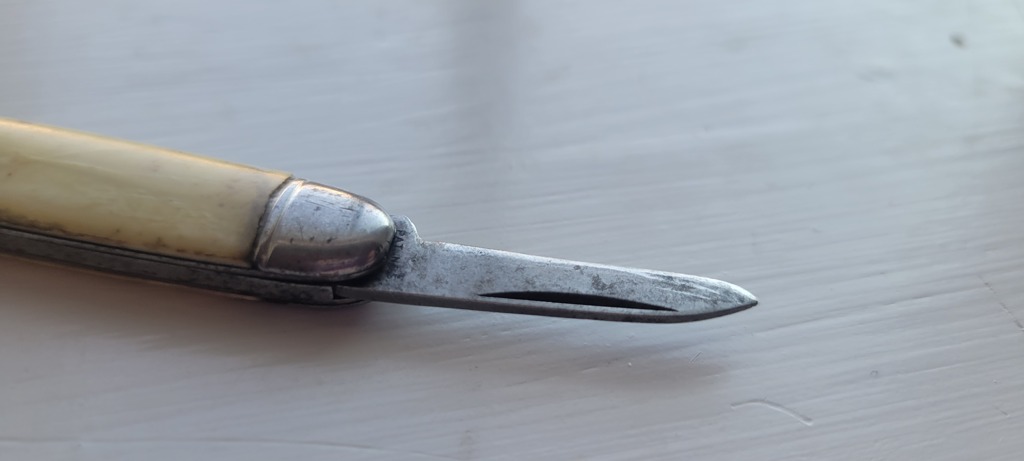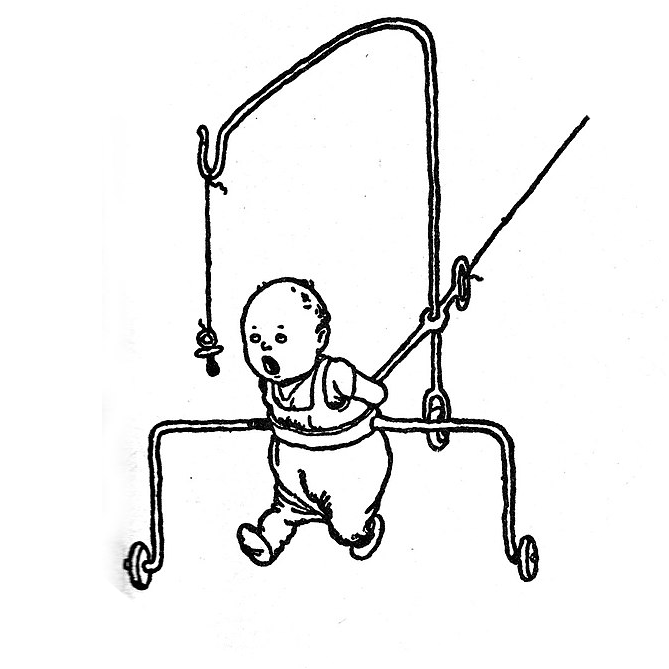There’s a patent number on the smaller of the blades near the hinge (2037943) that led me to a US patent from 1936 but it didn’t tell me a lot about this particular knife. Any information on time period, brand, model, cleaning/restoring, etc is helpful. Thanks!
Additional notes:
- I cleaned off a decent amount of rust with some soap and WD-40 but the inner workings are still pretty messy
- The yellow layer on the handles is peeling off at the ends
Update: thank you all so much for the information! I’ve gotten a lot of information and leads on the knife. Still nothing definite on brand but you’re probably right that it’s a carbon steel blade with an ivory handle from about the 1950s. I’ll be tending to it properly with your information on proper cleaning and sharpening of a knife like this. I’ll post another update if I find anything more definite on brand/origin. Thanks again!
By the title and picture, I seriously thought you were trying to figure out what a pocket knife was…
Thankfully I’m a bit more aware of things than that. I have multiple pocket knives already but they’re all modern while this is distinctly not. I perhaps could have been more descriptive haha
I am SO GLAD I’m not the only one.
The picture isn’t clear or well lit enough to really advise much as regards what to do with it.
So I’ll tell you what not to do with it.
Don’t polish, scrub, or in any way alter it.
Seriously. You have no idea how easy it is to fuck up a nice knife like that. I’m not saying you can’t did what you want with your own property, you can. Just be aware that the more you do it it trying to “restore” it, or even clean it without knowing what you’re doing, the more likely you are to destroy any and all historical or monetary value.
You already went at it with wd-40, which is not a good solvent for this kind of job. Tbh, it shouldn’t be used on knives at all. You want gun oils, they’re designed to penetrate, lubricate, and do so without gumming things up or damaging things like plastic, wood, or even leather (usually). Something like ballistol or rem-oil is what you use. If you can’t/won’t shell out for those, go to the drug store and get plain mineral oil. It isn’t as good at cleaning, but it won’t damage anything.
Use that to make sure you’ve gotten rid of the wd residue in the joints.
Then, get some pictures in even, diffuse lighting, showing the blade surfaces on each side, and down into the interior if possible.
Normally, a knife this old, if it isn’t red, yellow, or orange rust, it’s not going to need any intense work. You just clean it with warm, soapy water, then blow it dry, and apply whatever oil you prefer (I’m a pretty die-hard ballistol guy, but any gun oil will work fine). Then you either sharpen it for use and have fun with it, or you set it up for display/storage (which can be as simple or complicated as you want, with varying degrees of work and longevity).
The only thing wd 40 is good for with knives is knocking things loose on bare metal. It can discolor or damage too many of the handle/scale materials to be worth doing it with an intact knife like this.
There, I did my bit :)
It was a really good bit, especially about how not to damage it further. Thank you for taking the time.
I got some more pictures so hopefully this lighting works a little better. Washed in soapy water as requested and dried. I’m quite sure I’ve already messed some things up on it unfortunately but hopefully I can save it just a bit for at least usability. The handle material was already flaking when we found it and the inside is definitely pretty dirty/rusty still.
P.S. thanks for your help on this. Your response is really detailed and helpful.









That’s freaking great! Awesome pics.
So, while I can’t see anything to give you more info about the knife itself, at least not any more than others have already covered, you are in position to be able to have a really cool little knife.
There’s no visible red, orange, or yellow rust. That’s great. The interior looks clean enough that you’ve got plenty of time to get a better product to clean it the rest of the way. Typically, the gun oil and a few qtips will get that level of gunk taken care of in a half hour or so, maybe less.
That means all you have to do is basic maintenance from here. Keep it oiled, and I do recommend the same things again. The blades are carbon steel, so a bit of an oil coating on them is good.
The scales are showing their age, and there’s only so much you can do with them. I’m 99% sure they’re celluloid (though my eyes aren’t what they used the be). That stuff is really pretty, but degrades over time, and there aren’t really any methods to prevent that. The best you can do is keep it clean and dry, away from sunlight when not in use. Some folks will apply other materials to keep scales like that in place, but it’s never perfect. I have done some of that in the past, mostly with clear epoxy and careful polishing, but I regard it as a last ditch effort, but once celluloid gets degraded enough, there’s really nothing else to do.
That being said, there’s likely a decade or two of life in those scales, barring accidents.
Sharpening is fairly easy on those older knives, but if you need info, just holla.
Nice little knife there, it’s cool to see someone taking the time to put it to use :)
Thanks so much for taking the time to write this out! I’ll see about getting some gun oil and a small enough sharpener (the only one I own apparently doesn’t accommodate tiny pocket knives), and I may post an update on how it looks. I’m glad to see this little guy can be restored to working condition since a handy knife like this deserves a purpose, but I am a little sad that the scales might not have much longer (relatively speaking).
When I saw this post while scrolling, because of the particular community it’s posted to, I was worried that even pocket knives had become a forgotten relic of the past like VHS and phonographs.
You’re not the only one that thought that. I really need to clarify that I know it’s a pocket knife in the title so I don’t keep freaking people out as they’re casually scrolling.
Just looks like an ordinary pocket knife. That’s about it.
My father carried either one of those or one just like it. It was given to him by his father at a young age in the 50’s. Based on the other things that he had from his childhood, I expect it was a relatively affordable knife back then.
It sounds like ivory to me… (It flakes apparently. I think part of maintenance is painting a layer of dentin)
Deteriorated ivory tends to flake and peel along these lines.
(From This place which I admit to not vetting first - sorry)
 Reminded me of this “Hammer Brand” knife my grandparents gave me.
Reminded me of this “Hammer Brand” knife my grandparents gave me.Can’t help you much with the manufacturer. I can say that the blades will be a fairly simple carbon steel which will be easy to sharpen and will take a beautiful edge.






